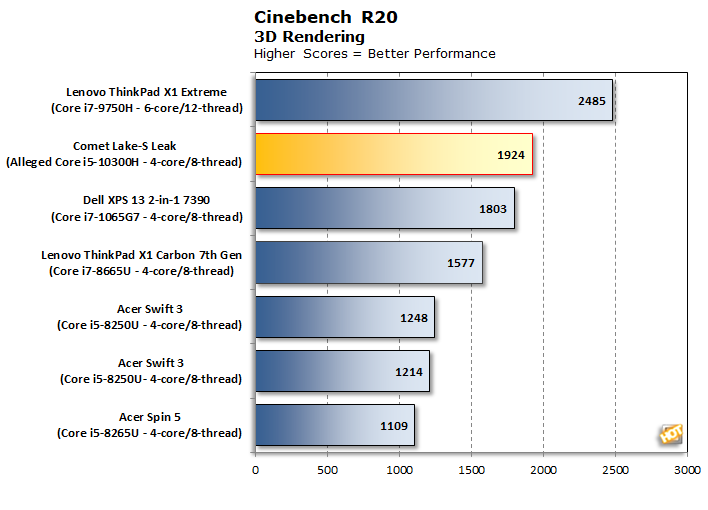
- #Cinebench r20 scores how to
- #Cinebench r20 scores full
- #Cinebench r20 scores pro
- #Cinebench r20 scores mac
- #Cinebench r20 scores windows
The Ryzen 4000 laptops actually open up their performance gap against The M1 and Intel chips even further when the run time is reduced.
#Cinebench r20 scores full
Laptops that can benefit from only running full tilt for three minutes versus more than 10 minutes get a decent 6 to 8 percent boost. Cinebench R23 allows you to actually turn off the “Throttle Test,” so we did that to record scores of Cinebench R23’s multi-core benchmark in a more traditional single render scene. The main take away is the single-threaded performance on the M1 as well as Intel’s Tiger Lake is nothing to dismiss.īut as we said, there is indeed a cost to be had for when you run every CPU core that hard on a laptop.
#Cinebench r20 scores how to
However, Joel Hruska at Extremetech (who worked on the results with Usman) argues the ball is really back in Intel and AMD’s court for how to address the limitations. There’s some conjecture that “we’re just not testing x86 right” as Usman Pirzada argues at WCCFtech. Its single-threaded prowess has pushed aside Ryzen 4000 and you see that here where both the M1 and the Core i7-1185G7 are basically tied in Cinebench R23. Neither does Intel’s Core i7-1185G7, to be fair. Single-threaded performance probably matters more for what most people do and the M1 doesn’t disappoint there either. An eight-core variant of an Intel H-chip would be even faster obviously.ĪMD, however, just shrugs at all this and yawns as its eight-core Ryzen 4000 chips easily beat all comers when set to their performance modes. But if you give Intel’s older six-core more thermal head room it’s almost dead even with the silent M1.
#Cinebench r20 scores mac
The performance is impressive though, with the eight-core M1 Mac now ahead of the four-core 11th-gen Tiger Lake as well as the older six-core Core i7-10710U. That can’t be said of the x86 laptops, which all vary from fairly quiet to a little rackety. Based on TSMC’s most advanced 5nm process, it’s a stone cold killer, with Macworld reporting no fan noise at all during the run. None of this bothers Apple’s M1 much though. With Cinebench R23 it now takes a minimum of 600 seconds to run under the new method. On a desktop or workstation with far more cooling it’s not an issue, but on laptops an all-core test that runs for at least 10 minutes can be far harsher-especially on CPUs that either make more heat, or laptops with more limited cooling. It’s actually called a “throttle test” which is a different method than before for Cinebench. On a six-core Intel H-class chip, Cinebench R15 takes 34 seconds to complete while Cinebench R20 takes about 108 seconds. The benchmark will even run beyond 10 minutes if the scene is still rendering when the timer hits zero. With Cinebench R23, the render scene is the same, but Maxon has interestingly changed it to render the same scene over and over for 10 minutes. With Cinebench R20, the benchmark would run render a single scene and produce a score based on its completion. Maxon released a new version of Cinebench R23 with native M1 support, but there are some other key changes which should be mentioned as well. We don’t know if the two are related, but we’d guess the M1 picks up a lot more mileage with native code. Some believe it to be as high as 30 percent, which coincidentally is matches the fee Apple takes from App Store purchases, sparking its war with Epic.
#Cinebench r20 scores pro
The Apple MacBook Pro M1? It’s really not bad again when you consider that Apple is paying a hefty translation penalty. For the x86 side, where Ryzen previously beat Core, it’s now flipped as we see Intel’s new 11th-gen Core i7-1185G7 leading the way. IDGĬinebench allows you to measure a single-threaded performance as well. And yes, the quad-core Core i7-1185G7 is faster too, despite the Mac have eight physical cores, but remember the translation penalty the MacBook is paying and how much it saps performance. Yes, you can look at the black bar below and see that the red Ryzen 4000 chipsstomp the M1 into the ground. Having to pay a real-time translation penalty typically blows chunks so we expected the M1 to cough up furballs, but it’s well-known now that Apple’s unlimited funding Apple and hard work has paid off handsomely. Maxon’s newer Cinema R23 offers native support for Apple’s M1 chip, but the older R20 version must use Apple’s Rosetta 2, a technology that handles just-in-tiime translation of x86 instructions to Arm from non-native code.
#Cinebench r20 scores windows
Cinebench R20 had versions for x86 on Windows and x86 on MacOS. It’s a 3D modelling benchmark built on the company’s in-house engine used in its commercial Cinema4D product.


We’ll kick off our results with Maxon’s older Cinebench R20. AMD Ryzen 4000 performance benchmarks Cinebench R20 performance


 0 kommentar(er)
0 kommentar(er)
